In life, things are not always certain. Consider the following situations:
- A candidate appearing for an interview for a job may or may not get the job
- It may or may not snow today.
- If a coin is tossed you might get a head or a tail (or neither if the coin falls on its edge).
- When a dice is thrown your chance of getting a 6 may or may not occur, since it is equally likely that a 1, 2, 3, 4, or 5 may turn up.
These situations have no definite answer. They involve an element of uncertainty. The 'Probability Theory' is designed to estimate the degree of uncertainty regarding the happening of a given phenomenon.
Probability is used in various situations in physical, biological, and social sciences.
Suppose you toss a dice once, what are the possible outcomes? A dice, obviously can fall with any of its faces uppermost. The number on each face is a possible outcome. If the dice is well-balanced, it is likely to show a 2, or a 1, 3, 4, 5, 6.
Since there are 6 equally likely outcomes 1, 2, 3, 4, 5 or 6 in a single throw of a dice and there is only one way of getting a particular outcome say ‘ 6 ', therefore the chance of getting 6 is one in six. Or the probability of getting a 6 is 1/6. We write this as P (6) = 1/6
Similarly if you toss a coin it can show a head (H) or a tail (T). So there are only two equally likely outcomes. The probability of getting a tail is one in two or 1/2.

The outcome is also called an event (E). We write the probability of an event as P (E) and define it as

In the case of tossing a dice, the total number of outcomes in the set {1, 2, 3, 4, 5, 6} is 6. If we want a 6 then we just have 1 favorable outcome as there's only one outcome of 6 on a dice.

The set {1, 2, 3, 4, 5, 6} is called a Sample space and each Outcome is called a Sample point. Tossing a coin or a dice is called a Random
Experiment.
What is the probability of getting an '8' if a dice is tossed once? Since none of the faces is marked by an 8, getting an eight is impossible. Such an event is called an impossible event and we have

The Probability of an impossible event is zero.
The probability of getting a 1, 2, 3, 4, 5 or 6 when a dice is tossed i.e. a number less than 7 is certain to happen or P (< 7) = 6/6 = 1.
This is called a sure event.
We know that the probability of getting a number 6 in the throw of a dice is 1/6. What is the probability of getting a number other than 6? The numbers are 1, 2, 3, 4 or 5 or 5 favorable outcomes.
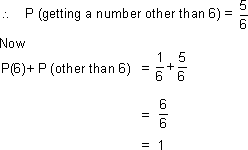
We can write P (other than 6) as P (not 6)
Then
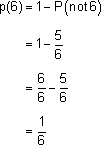
We thus have the formula for any event E
P (E) + P ( Ē ) = 1
and P (E) = 1-P( Ē )
P (Ē) = 1- P (E)
P ( Ē) indicates P(not E).
Example 19:
A dice is thrown once. What is the probability of getting
- A number 3 or 4?
- An odd number?
- A prime number?
Solution:
- Number of favorable outcomes getting a 3 or 4 = 2
Total number of outcomes = 6
Required probability: P(E)
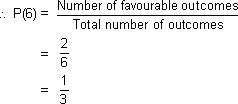
- Number of odd numbers = 3, since the only odd numbers are 1, 3, and 5
Number of favorable outcomes = 3
Total number of outcomes = 6
Probability of event = P(E)
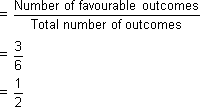
- Number of prime number = 3, since the only prime numbers are (2, 3, 5)
Number of favorable outcomes = 3
Total number of outcomes = 6
Probability of the event = P(E)
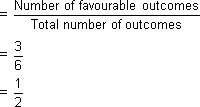
Example 20:
If one card is drawn from a well shuffled deck of 52 cards, find the probability that the card is
- a diamond
- an ace
- a black card
- not a diamond
- not an ace
- not a black card
- a club or a heart
- a club and a king
Solution:
- In a pack of 52 cards there are 13 diamond cards
Number of favorable outcomes = 13.
Total number of outcomes = 52
Probability of the event = P(E)
(getting diamond)
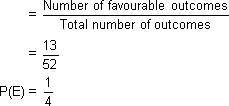
- Number of aces in a deck of 52 cards is 4
Number of favorable outcomes = 4
Total number of outcomes = 52
Probability of the event = P(E)
(getting an ace)
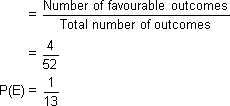
- The number of black cards in a deck of 52 cards is 26
13 of clubs
13 of spades
Number of favorable outcomes = 26
Total number of outcomes = 52
Probability of the event = P(E)
(getting a black card)
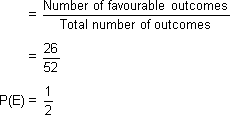
- Since the probability P (E) of getting a diamond is 1/4
The probability of not getting a diamond

- Probability of getting an ace = P (E) = 1/13
Probability of not getting an ace = 1-P (E)

- Probability of getting a black card = P (E) = 1/2
Probability of not getting a black card = P (Ē) = 1 – P (E)

- Probability of getting a club or a heart
Number of club cards in a deck = 13
Number of heart cards in a deck = 13
Number of favorable outcomes = 13 + 13 = 26
Total number of outcomes = 52
Probability of the event = P(E)
(getting a club or a heart)
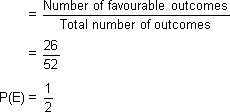
- A club and a king
Since there is only one king of clubs
Number of favorable outcomes = 1
Total number of outcomes = 52
Probability of the event = P(E)
(getting a club or a king)

Try these problems:
- A dice is thrown twice. Find the probability of getting a sum of six in these throws.
- A coin is tossed thrice, write its sample space.
- From a well shuffled deck of cards find the probability of
- Getting '2' of hearts.
- Getting a king or a queen or a jack.
- Not getting an ace.
- Getting a red card
Answer:
- A dice is thrown twice.
Sample space S = {(1,1), (1, 2),(1,3), (1,4),(1,5), (1,6)
(2,1), (2, 2),(2,3), (2, 4),(2,5), (2, 6)
(3,1), (3, 2),(3,3), (3, 4),(3,5), (3, 6)
(4,1), (4, 2),(4,3), (4, 4),(4,5), (4, 6)
(5,1), (5, 2),(5,3), (5, 4),(5,5), (5, 6)
(6,1), (6, 2),(6,3), (6, 4),(6,5), (6, 6)}
Total number of outcomes= 36 = n(S)
A = event of getting a sum of six
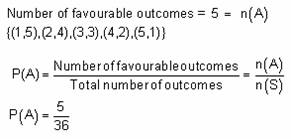 >
>
- A coin is tossed thrice
Sample space S = {HHH, HHT, HTH, HTT, THH, TTH, THT, TTT}
Total number of outcomes = 23 = 2 * 2 * 2 = 8
- Total number of outcomes = Total number of cards
= n(S)
n(S) = 52
- A = event of getting ' 2 ' of hearts
n(A) =1 = number of favorable outcomes

 Probability of getting a ' 2 ' of hearts is
Probability of getting a ' 2 ' of hearts is
- A = event of getting a king
n(A) = number of favorable outcomes = 4
B = event of getting a queen
n(B) = number of favorable outcomes = 4
C = event of getting a jack
n(c) = number of favorable outcomes = 4
Since getting a king or a queen or a jack are mutually exclusive events
P(A or B or C) = P (A ∪ B ∪ C) = P(A) + P (B) + P (C)
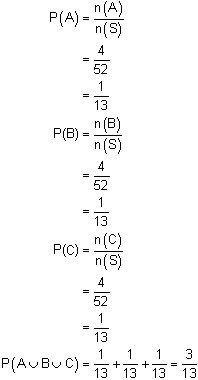
- A = event of getting an ace
n(A) = number of favorable outcomes = 4
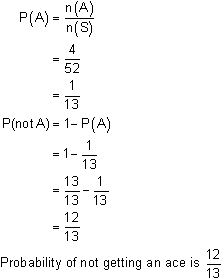
- R = event of getting a red card
n(R) = number of favorable outcomes
= 26 (13 diamonds + 13 hearts)
s

 Probability of getting a red card is
Probability of getting a red card is